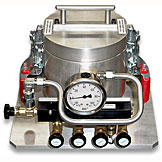
The purpose of the PV-833 Junior bombing station is to “bomb” hermetically sealed components prior to leak testing. The ‘Helium Bomb” technique of leak testing is a method of testing components that have been sealed with no helium tracer gas inside. In order to introduce helium into the device, it is placed in a container and externally pressurized with helium at pressures varying typically from 2 atm to 5 atm and for periods from 1 to 10 hours. If a leakage path exists, helium will enter the component through the leak and it may then be tested on a Helium Mass Spectrometer Leak Detector.
FEATURES
| SPECIFICATIONS |
|---|
| Chamber Size | 5” Diameter x 3” deep chamber or 9.5” Diameter x 9.5” deep |
|---|---|
| Maximum Operating Pressure | 100 psi |
| Pump | 2.0 CFM direct drive mechanical pump with coaxial trap |
| Operation | Controls provide initial evacuation, venting after bombing and purging of the chamber with Nitrogen and other gases |
| Valves | Manual helium, evacuation, N2 purge and vent |
| Safety | 100 psi pressure relief valves |
| Dimensions | 5” Diameter x 3” deep; 9.5” Diameter x 9.5” deep |
| Shipping Weight | 100 lbs |
| Power Requirements | – |
| Other | De-Staco chamber lid hold-down clamps. integral valve block manifold, mounts to table top |
 Vacuum Instruments Corporation is a pioneer in providing state-of-the-art leak detection solutions for diverse applications and industries. Our systems have ensured the safety and performance of countless products that we use in our daily lives from the cars we drive to the air conditioners in our houses, the pacemakers in our bodies, and the satellites we launch into space.
Vacuum Instruments Corporation is a pioneer in providing state-of-the-art leak detection solutions for diverse applications and industries. Our systems have ensured the safety and performance of countless products that we use in our daily lives from the cars we drive to the air conditioners in our houses, the pacemakers in our bodies, and the satellites we launch into space.